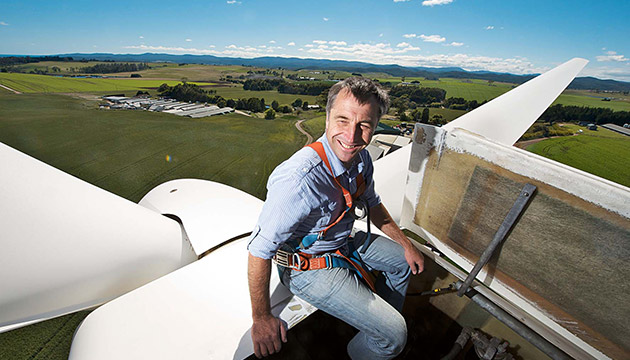Farmers across Australia are investing in renewable energy to help drought-proof properties and give them a more diverse income stream, as well as the added benefits to the environment.
Story By Amanda Burdon
Amid the lush green pastures of Sassafras, in northern Tasmania, poultry farmer Robert Nichols is hatching a bold plan for rural revival – a plan that would see agricultural communities assume control of energy production and distribution.
Fresh from overseas travels as part of a Nuffield scholarship, Robert can see a time in the not-too-distant future when community-owned and managed renewable energy schemes based around wind, solar and hydro supply most of Australia’s energy requirements.
“I envisage community-owned wind farms or other renewable energy production under the control of primary producers,” he says. “Farmers hold the resource that can provide this energy and they could become the conduit for building skills and related industries in their communities. Renewable energy production could be at the heart of a new rural economy. We just need to get organised.”
In 2008, Robert and his family installed a 225-kilowatt wind turbine to generate a significant proportion of the energy needs of Nichols Poultry, which annually produces more than 750,000 chickens and 30,000 turkeys. Robert’s ambition is for the company to become self-sufficient by 2020 and – one day – carbon neutral. He is dedicated to reducing food miles and buys feed from local grain growers. In an effort to become more environmentally sustainable, Nichols Poultry also pays a premium to its broiler chicken farmers to “reward them for embracing environmental techniques”.
On the other side of the continent, a very different power model is being proposed to capitalise on the burgeoning interest in biofuels, which currently supply less than 0.5 percent of Australia’s transport fuel. Although the Federal Government has implemented the Mandatory Renewable Energy Target scheme, and recently committed to a target of 20 percent energy supplied from renewable sources by 2020, investment in bioenergy projects has, until now, been small.
Most of Australia’s ethanol and biodiesel is made from wastes and the co-products of food production, such as C-molasses, waste starch and tallow, but supplies are considered insufficient for large-scale and ongoing biofuel production, and there are concerns about the diversion of grains and sugars from food production. The Renewable Oil Corporation (ROC) instead plans to establish a second-generation biofuel plant in southern Western Australia that makes transport fuels from the residues of existing pine and blue-gum plantations. It also hopes to stimulate commercial demand for farm-based mallee eucalypts, which currently cover some 13,000 hectares.
This story excerpt is from Issue #81
Outback Magazine: Feb/Mar 2012










